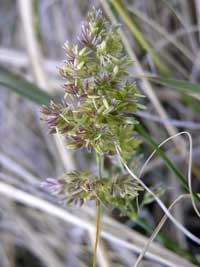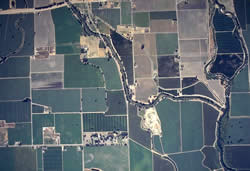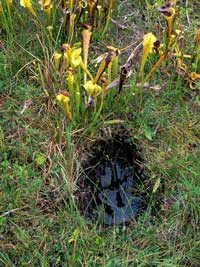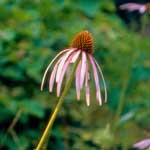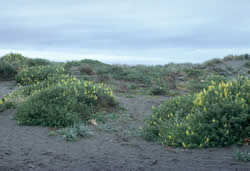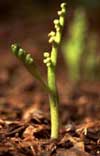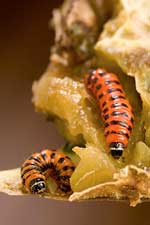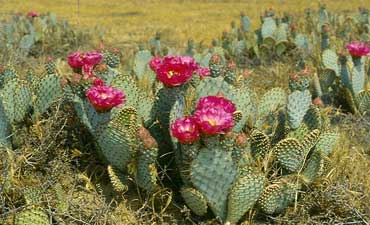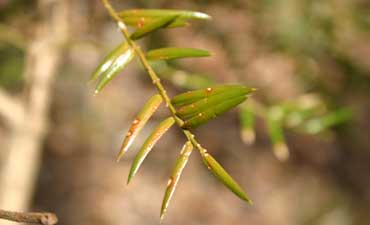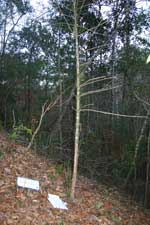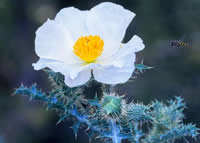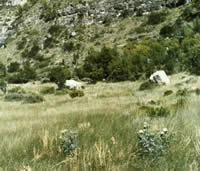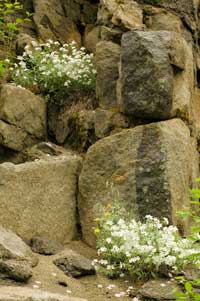USDA Forest Service Celebrating Wildflowers
|
|
|
Why Are Some Plants Rare?
Some plants are naturally rare, and the cause may be a mystery. These rare plants are not necessarily in danger of extinction. If their habitat is secure and they continue to reproduce in the wild, no intervention is needed. Botanists do agree that rare plants are more likely to become extinct than more common species. There are particular life history characteristics recognized by scientists as increasing a plant species’ risk of extinction. A few examples of these natural risk factors are:
Other plants that were formerly more common have become rare because of changes in their environment. These changes are often brought on directly or indirectly by people’s patterns of settlement, transportation, recreation, and use of natural resources. We can help rare species recover and even thrive sometimes by making changes in our own behaviors. For most species, rarity results from some combination of anthropogenic (human-induced) and evolutionary ("natural") factors rather than a single cause. Human causes of rarity, direct and indirect, are identifiable for many rare plants. The more common are:
The following further discussion of the causes of rarity will move back and forth between natural and human-caused reasons for rarity, as they are so intertwined in nature. Loss of HabitatMany scientists make a point of distinguishing between species that naturally occur in small, isolated populations and those that have been fragmented and diminished by human activity. Plant species that were once widespread, interbreeding, and diverse are most sensitive to declines in genetic variation associated with restrictions in range or population size. Loss of habitat prohibits buildup of population numbers from periodic lows. A habitat or population fragment is a smaller target for incoming seeds being dispersed from another habitat patch; therefore, recolonization may be problematic.
Some plants are naturally restricted to rare, patchy habitats, such as limestone or serpentine rock outcrops, balds, and vernal pools. From a conservation perspective, these are the easiest habitats to model, map, and survey for plants, and often the easiest to protect. Occurrences of plants confined to these habitats can be predicted by the distribution of the habitats. The habitats can be seen and outlined on an aerial photo or soil map of suitable resolution. However, these patchy habitats, especially if the patches are small, are very susceptible to careless or intentional destruction, especially if the patches contain some economically valuable commodity (such as minerals or landscape rock), or are embedded in an economically valuable matrix (such as woodland habitat that is attractive for housing). In addition, a too-tight focus on habitat patches, leaving out surrounding matrix habitat when planning for species conservation, can lead to loss of essential ecological relationships and, ultimately, failure to conserve the target species. For example, andrenid bees, critical pollinators of California vernal pool genera such as Downingia and Limnanthes, nest in the upland matrix surrounding the pools. A conservation plan that overlooks this relationship is likely to be unsuccessful. The most common cause of plant habitat loss and subsequent plant rarity and endangerment is conversion of native plant habitat to cities, farms, roads, and regulated-flow river systems and reservoirs. Human settlement has also changed plant habitats through fire suppression, introduction of aggressive weeds, recreational use, and natural resource extraction. Loss of Pollinators, Dispersal Agents, or Other Plant PartnersAbout one-fifth of all pollen-producing plants have pollen light enough to float on wind or water. Noteworthy members of this group are conifers, oaks, grasses, and sagebrush, typical "hay fever" culprits. The rest have heavier pollen, and must rely on animals to move pollen from one flower to the next. Insects (bees, flies, beetles, butterflies, moths, and wasps) do most animal pollination of native plants, but some plants rely on birds or bats for pollen transfer. Water, wind, animals, or mechanical means disperse fruits and seeds. The purpose of any dispersal system is to get seeds to a suitable patch of habitat that is not already occupied. Timing is critical: the dispersal agent must be available at the time the seeds are ready for dispersal. Distance among habitat patches is also critical. If the distance to the next habitat patch exceeds the dispersal range of the species, that habitat patch has no way to be recolonized should the local population be lost through disease, predation, or local natural catastrophe.
Animal dispersed seeds stick to the animal in some way, with hooks, mucilage, or mud from wet habitats, or are eaten and passed through the digestive system. Seeds that are eaten include berries, nuts, or those with a fleshy aril or elaiosome that offers some nutritive value to the dispersing creature. Berries and nuts, since they are relatively large, tend to be used and dispersed by larger animals (birds and mammals) with longer dispersal distances. Seeds with elaiosomes, such as in trilliums and violets, are dispersed by ants. This limits the dispersal distance of the seeds and colonies of plants may become isolated by large expanses of unsuitable habitat.
The importance of mycorrhizal associations (plants with roots connected to fungal hyphae to extend their nutrient-gathering ability) to seedling germination and survival has been documented for a wide variety of habitats, including grasslands, sagebrush scrub, wetlands, tallgrass prairie, as well as forests. Mycorrhizal fungi are sensitive to soil disturbance, solar heating of soil, and pesticides. The mycorrhizal flora is currently susceptible to wholesale change through air-borne nitrogen enrichment of the soil that is occurring worldwide. Species dependent on specific mycorrhizal associations, such as terrestrial orchids and moonworts (Botrychium species) may be at special risk because of the vulnerability of their fungus partners to environmental changes.
Collecting for Gardens, Medicinal Use, or ScienceCertain groups of rare plants, among them cacti, orchids, and carnivorous plants, are particularly attractive to collectors. Sadly, these slow-growing plants do not recover quickly from the collectors’ hand, nor do many take well to cultivation. Collecting plants that are listed under the Endangered Species Act from Federal lands is illegal (per Section 9 of the Endangered Species Act). Native plants collected from wildlands for the herbal or medicinal market are sometimes harvested faster than they can grow back, leading to population declines. This is especially true where the roots or the whole plant is harvested rather than just the tops. Wild plants on public lands belong to all the people of the United States, and it is illegal to collect them without a permit. Continued unpermitted collection contributes to the increasing rarity of other natives.
In a few cases, repeated collection of herbarium specimens from rare plant populations has caused significant impacts, especially where only one or a few small populations of the rare plant existed. One such example is Robbins’ cinquefoil, Potentilla robbinsiana, which faced dire threats from overcollection and trampling by hikers and was listed as Endangered in 1980. Happily, this species has since rebounded and has been delisted because of collaborative recovery efforts by the Appalachian Mountain Club, New England Wild Flower Society, U.S. Fish and Wildlife Service, and the White Mountain National Forest. For the complete story, see Recovery of Robbin’s Cinquefoil – A Partnership Success. See Ethics and Native Plants for more information about plant collection. Competitors, Pathogens, and Pests
For Botrychium mormo (little goblin moonwort), a very small moonwort fern that occurs only in the rich deciduous forests of northern Minnesota, Wisconsin, and Michigan, the primary long-term threat to population viability is probably the effect of exotic earthworms, which are spreading throughout the Great Lakes region. These earthworms can completely consume the organic horizon, thus eliminating B. mormo habitat and populations. Invasive non-native weeds have contributed to the decline of nearly half of the plants listed as endangered or threatened under the Endangered Species Act. Invasives are the main cause of the decline of 18 percent of endangered or threatened species in the United States. Weeds compete directly with native plants for water, nutrients, and light. In the Western United States, cheatgrass, knapweeds, yellow star thistle, and scotch broom are frequent rare plant competitors. In the Eastern United States, woody garden escapees such as honeysuckle and privet often are the culprits. See Invasive Plants for more information. Disease organisms and predators are not often documented as causal agents in the decline of rare species. When other organisms are implicated as reasons for decline, they are usually non-native pathogens or invertebrates that have not co-evolved with our native plants. A remarkable example is that of earthworms in the Great Lakes Region. There are no earthworms native to the Great Lakes Region. Native earthworms were eliminated from the Lake States during the last ice age. European earthworms were introduced into North America with European settlement. They were then spread as the earthworms were used for fishing bait, in gardening, and were accidentally transported. We usually think of earthworms as benign or beneficial, but earthworms also dramatically reduce the litter and duff layers of forest soils. This can prove disastrous for forest floor plants that thrive in the rich organic layer at the soil’s surface. The invasive cactus moth, Cactoblastis cactorum, a South American native, was first detected in Florida in 1989, and has established in areas as far north as South Carolina and as far west as the Florida panhandle. Nine species of prickly pear endemic to the United States are at risk from the cactus moth, including Bakersfield cactus, which is listed as Endangered, and several other species of state or local conservation concern. Cactoblastis cactorum has been rapidly expanding its range along the Gulf of Mexico, and pathways of introduction to the southwestern U.S. and Mexico likely include both natural dispersal and commercial trade. See "Preliminary assessment of the potential impacts and risks of the invasive cactus moth, Cactoblastis cactorum Berg, in the U.S. and Mexico" (PDF, 0.7 MB).
Case Study - Disease and Florida TorreyaAs recently as the 1950s, Florida torreya, Torreya taxifolia, was a common canopy tree in the ravine forests of its narrow geographic range along the east side of the Apalachicola River, on the Florida panhandle. The species declined suddenly and precipitously in the late 1950s, apparently because of fungal disease. Scientists estimate that only two percent of historic wild Florida torreya numbers remain today. The plant was listed as Endangered in 1984. Yet, the species continues to hang on in the wild. Remarkably, habitat loss was not implicated in the species decline. Most of the ravine forest habitat in the Apalachicola River watershed that formerly supported wild populations of Florida torreya remains intact.
Hope remains for recovery of the species to its former numbers. Efforts are underway by several organizations to establish and protect Florida torreya groves in places uncontaminated by its disease organisms, to produce seeds for restoring wild populations. Effects of Climate Change to Rare PlantsClimates have been in flux as far back as geologic evidence can be read. Paleobotanical evidence shows that vegetation has migrated and evolved repeatedly in response to climate change. This trend seems likely to continue. The questions seem to be at what rate and with what influence by human activity. Ecologists currently agree that, in the future as in the past, vegetation will not shift or migrate as intact biomes or communities. Individual species have different migration rates and different responses, and will probably form new assemblages not now seen. Scientists suggest that mycorrhizal migration rates may limit vascular plant migration rates. If this is the case, species dependent on a single mycorrhizal fungus, or to both a fungus and a woody host plant (as for sugar stick or phantom orchid), would be at a disadvantage in adapting rapidly to climate change. Successful adaptive migration also depends on the presence of continuous migration corridors of friendly habitat. This is likely to be a problem for many species, but especially for those already limited to isolated, patchy habitats and dependent on specialized pollinators and dispersal agents. Global warming, linked to human-induced increases in CO2 and other "greenhouse gases" is a scenario addressed by plant conservationist David Given: “A vertical ascent of around 500 meters could compensate for a 3° C rise in average temperature, but because available land area decreases with increasing altitude, species with large habitat area requirements may become extinct. In any case, associations of species will be squeezed into decreasing areas as they ascend.” Since plant species with large habitat requirements tend to be wind- pollinated (such as conifer trees and prairie grasses), this would place many widespread woody plants and graminoids currently limited to middle and upper montane zones at risk. Some alpine species would simply "wink out" under a global warming scenario, as there would be no higher elevation habitat nearby to which they could migrate. Case Study: Drought and the Sacramento Prickly Poppy
The Sacramento prickly poppy (Argemone pleiacantha ssp. pinnatisecta), always a rare plant, was designated as endangered on August 24, 1989. The plant grows in canyons on the western slope of the Sacramento Mountains near Alamogordo, New Mexico. Severe drought in the Southwest began in the late 1990s and persisted until 2006 when there was near-record summer rain and above average winter snow. It is uncertain if 2006 marked the end of the drought or is only a temporary reprieve. Tree ring records of climate in the Southwest for the last 800 years show many droughts lasting 15 to 25 years. As the drought extended, the number of prickly poppies began to fall. By 2004, the total had fallen to 425 plants, a 68 percent reduction from the number in the late 1980s. Worse yet, the populations in four canyons had disappeared completely and had dropped to four or fewer plants in two other canyons. As concern for the prickly poppy grew, more time was spent looking for seedlings and young plants. Seedlings were seen as early as February in the lower parts of the canyons, but every drought year had the same result. With no spring moisture, the seedlings all died before the summer rains began in July and August. How long can prickly poppy populations persist with the death of older plants, no recruitment of new plants, and depletion of the soil seed bank as seedlings die? Populations are already gone in four canyons and natural dispersal is unlikely to replenish these populations anytime soon. Continued drought could lead to extinction of the Sacramento prickly poppy. Several recovery projects for the Sacramento prickly poppy have been tried or are being planned. In one project, members of the local chapter of the Native Plant Society of New Mexico volunteered to water prickly poppy seedlings to see if supplemental water would carry them through the dry spring. A watered plot and a non-watered control plot were set up. The volunteers carried water in backpack sprayers and watered the plants once a week for several months. Unfortunately, this effort was unsuccessful because seedling survival in the non-watered control plot was higher than in the watered plot, which in both cases was less than 10 percent when the watering ended. In another project, the Forest Service, University of New Mexico, Rio Grande Botanical Garden, and State of New Mexico planned to supplement one population that formerly had about 150 plants, but by 2005 had dropped to only four plants, with plants grown at the botanical garden. However, when the team visited the site in the early fall of 2006, they discovered many healthy young plants that had come up with the unusually heavy and prolonged summer rains. They decided instead to monitor the young plants to see if a new cohort of prickly poppies would become established and bring the population back to former levels. If that happens, even if the drought resumes, these plants could keep the seed bank replenished for at least the next decade. Stochastic Risk
Rarity itself leads to an increased risk of endangerment and extinction, because rare plants with few and small populations are less able to recover from random events that wipe out individuals or entire populations. This kind of risk is called “stochastic risk”. In SummaryRare plants fall into several general categories of risk:
The hardest work of rare plant conservation comes with the last group, where the natural causes of rarity and the human causes of rarity have to be teased apart before it is possible to find conservation solutions. |
|
| NOTE: PDF format links require the Adobe Acrobat Reader to view. | |
| top | Disclaimers | FOIA | Privacy Policy | Quality of Information | Photo Credits & Use |
Location: http://www.fs.fed.us/wildflowers/rareplants/whyare/index.shtml
Last modified: Friday, 16-May-2008 13:44:46 EDT
